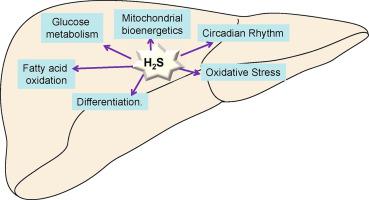Journal of Advanced Research ( IF 10.7 ) Pub Date : 2020-05-17 , DOI: 10.1016/j.jare.2020.05.010 Hai-Jian Sun 1 , Zhi-Yuan Wu 1 , Xiao-Wei Nie 1 , Xin-Yu Wang 2 , Jin-Song Bian 1, 3

|
Background
Over the last several decades, hydrogen sulfide (H2S) has been found to exert multiple physiological functions in mammal systems. The endogenous production of H2S is primarily mediated by cystathione β-synthase (CBS), cystathione γ-lyase (CSE), and 3-mercaptopyruvate sulfurtransferase (3-MST). These enzymes are widely expressed in the liver tissues and regulate hepatic functions by acting on various molecular targets.
Aim of Review
In the present review, we will highlight the recent advancements in the cellular events triggered by H2S under liver diseases. The therapeutic effects of H2S donors on hepatic diseases will also be discussed.
Key Scientific Concepts of Review
As a critical regulator of liver functions, H2S is critically involved in the etiology of various liver disorders, such as nonalcoholic steatohepatitis (NASH), hepatic fibrosis, hepatic ischemia/reperfusion (IR) injury, and liver cancer. Targeting H2S-producing enzymes may be a promising strategy for managing hepatic disorders.
中文翻译:

硫化氢在肝脏病理生理学中的意义:机制见解和治疗潜力
背景
在过去的几十年中,已发现硫化氢 (H 2 S) 在哺乳动物系统中发挥多种生理功能。H 2 S 的内源性产生主要由胱硫醚 β-合酶 (CBS)、胱硫醚 γ-裂解酶 (CSE) 和 3-巯基丙酮酸硫转移酶 (3-MST) 介导。这些酶在肝组织中广泛表达,并通过作用于各种分子靶点来调节肝功能。
审查目的
在本综述中,我们将重点介绍肝病下由 H 2 S引发的细胞事件的最新进展。还将讨论H 2 S供体对肝病的治疗作用。
审查的关键科学概念
作为肝功能的关键调节因子,H 2 S 与各种肝脏疾病的病因学密切相关,例如非酒精性脂肪性肝炎 (NASH)、肝纤维化、肝缺血/再灌注 (IR) 损伤和肝癌。靶向产生 H 2 S 的酶可能是治疗肝病的有希望的策略。


























 京公网安备 11010802027423号
京公网安备 11010802027423号